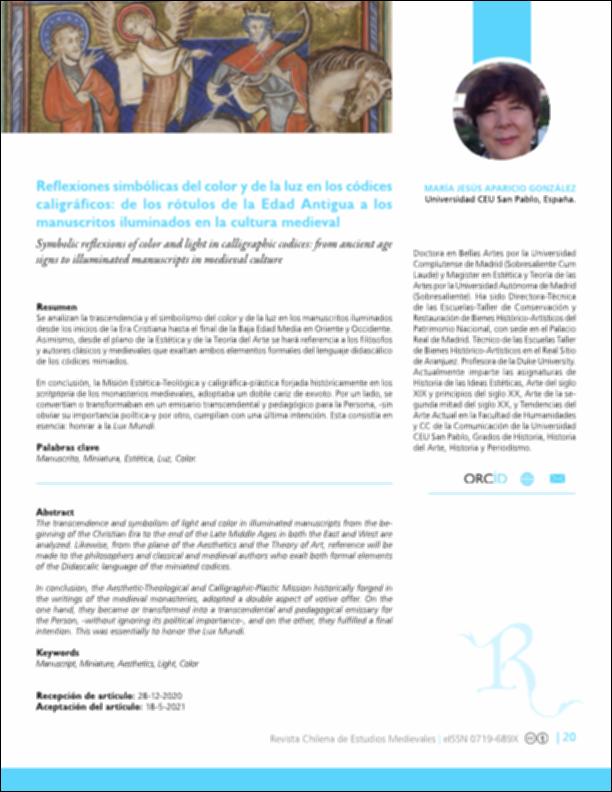Please use this identifier to cite or link to this item:
http://hdl.handle.net/10637/14964Reflexiones simbólicas del color y de la luz en los códices caligráficos: de los rótulos de la Edad Antigua a los manuscritos iluminados en la cultura medieval
| Title: | Reflexiones simbólicas del color y de la luz en los códices caligráficos: de los rótulos de la Edad Antigua a los manuscritos iluminados en la cultura medieval Symbolic reflexions of color and light in calligraphic codices: from ancient age signs to illuminated manuscripts in medieval culture |
| Authors : | Aparicio González, María Jesús |
| Keywords: | Manuscrito; Miniatura; Estética; Luz; Color; Manuscript; Miniature; Aesthetics; Light; Color |
| Publisher: | Universidad Gabriela Mistral: Centro de Estudios Medievales |
| Citation: | Aparicio González, M. J. (2021). Reflexiones simbólicas del color y de la luz en los códices caligráficos: de los rótulos de la Edad Antigua a los manuscritos iluminados en la cultura medieval. Revista chilena de estudios medievales, (19), 20-30. |
| Abstract: | Se analizan la trascendencia y el simbolismo del color y de la luz en los manuscritos iluminados
desde los inicios de la Era Cristiana hasta el final de la Baja Edad Media en Oriente y Occidente.
Asimismo, desde el plano de la Estética y de la Teoría del Arte se hará referencia a los filósofos
y autores clásicos y medievales que exaltan ambos elementos formales del lenguaje didascálico
de los códices miniados.
En conclusión, la Misión Estética-Teológica y caligráfica-plástica forjada históricamente en los
scritptoria de los monasterios medievales, adoptaba un doble cariz de exvoto. Por un lado, se
convertían o transformaban en un emisario transcendental y pedagógico para la Persona, -sin
obviar su importancia política-y por otro, cumplían con una última intención. Esta consistía en
esencia: honrar a la Lux Mundi. The transcendence and symbolism of light and color in illuminated manuscripts from the beginning of the Christian Era to the end of the Late Middle Ages in both the East and West are analyzed. Likewise, from the plane of the Aesthetics and the Theory of Art, reference will be made to the philosophers and classical and medieval authors who exalt both formal elements of the Didascalic language of the miniated codices. In conclusion, the Aesthetic-Theological and Calligraphic-Plastic Mission historically forged in the writings of the medieval monasteries, adopted a double aspect of votive offer. On the one hand, they became or transformed into a transcendental and pedagogical emissary for the Person, -without ignoring its political importance-, and on the other, they fulfilled a final intention. This was essentially to honor the Lux Mundi. |
| URI: | http://hdl.handle.net/10637/14964 |
| Rights : | http://creativecommons.org/licenses/by-nc-nd/4.0/deed.es OpenAccess |
| ISSN: | 0719-689X |
| Issue Date: | 22-Jun-2021 |
| Center : | Universidad San Pablo-CEU |
| Appears in Collections: | Facultad de Humanidades y CC de la Comunicación |
Items in DSpace are protected by copyright, with all rights reserved, unless otherwise indicated.


